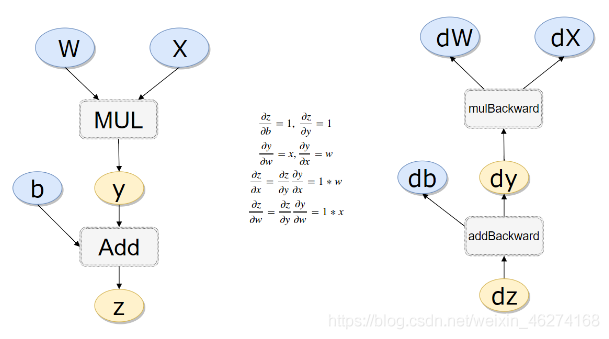PyTorch一小时掌握之autograd机制篇
目录
- 概述
- 代码实现
- 手动定义求导
- 计算流量
- 反向传播计算
- 线性回归
- 导包
- 构造 x, y
- 构造模型
- 参数 & 损失函数
- 训练模型
- 完整代码
概述
PyTorch 干的最厉害的一件事情就是帮我们把反向传播全部计算好了.
代码实现
手动定义求导
import torch # 方法一 x = torch.randn(3, 4, requires_grad=True) # 方法二 x = torch.randn(3,4) x.requires_grad = True
b = torch.randn(3, 4, requires_grad=True) t = x + b y = t.sum() print(y) print(y.backward()) print(b.grad) print(x.requires_grad) print(b.requires_grad) print(t.requires_grad)
输出结果:
tensor(1.1532, grad_fn=<SumBackward0>)
None
tensor([[1., 1., 1., 1.],
[1., 1., 1., 1.],
[1., 1., 1., 1.]])
True
True
True

计算流量
# 计算流量 x = torch.rand(1) w = torch.rand(1, requires_grad=True) b = torch.rand(1, requires_grad=True) y = w * x z = y + b print(x.requires_grad, w.requires_grad,b.requires_grad, z.requires_grad) print(x.is_leaf, w.is_leaf, b.is_leaf, y.is_leaf,z.is_leaf)
输出结果:
False True True True
True True True False False
反向传播计算
# 反向传播 z.backward(retain_graph= True) # 如果不清空会累加起来 print(w.grad) print(b.grad)
输出结果:
tensor([0.1485])
tensor([1.])
线性回归
导包
import numpy as np import torch import torch.nn as nn
构造 x, y
# 构造数据 X_values = [i for i in range(11)] X_train = np.array(X_values, dtype=np.float32) X_train = X_train.reshape(-1, 1) print(X_train.shape) # (11, 1) y_values = [2 * i + 1 for i in X_values] y_train = np.array(y_values, dtype=np.float32) y_train = y_train.reshape(-1,1) print(y_train.shape) # (11, 1)
输出结果:
(11, 1)
(11, 1)
构造模型
# 构造模型
class LinerRegressionModel(nn.Module):
def __init__(self, input_dim, output_dim):
super(LinerRegressionModel, self).__init__()
self.liner = nn.Linear(input_dim, output_dim)
def forward(self, x):
out = self.liner(x)
return out
input_dim = 1
output_dim = 1
model = LinerRegressionModel(input_dim, output_dim)
print(model)
输出结果:
LinerRegressionModel(
(liner): Linear(in_features=1, out_features=1, bias=True)
)
参数 & 损失函数
# 超参数 enpochs = 1000 learning_rate = 0.01 # 损失函数 optimizer = torch.optim.SGD(model.parameters(), lr=learning_rate) criterion = nn.MSELoss()
训练模型
# 训练模型
for epoch in range(enpochs):
# 转成tensor
inputs = torch.from_numpy(X_train)
labels = torch.from_numpy(y_train)
# 梯度每次迭代清零
optimizer.zero_grad()
# 前向传播
outputs = model(inputs)
# 计算损失
loss = criterion(outputs, labels)
# 反向传播
loss.backward()
# 更新参数
optimizer.step()
if epoch % 50 == 0:
print("epoch {}, loss {}".format(epoch, loss.item()))
输出结果:
epoch 0, loss 114.47456359863281
epoch 50, loss 0.00021522105089388788
epoch 100, loss 0.00012275540211703628
epoch 150, loss 7.001651829341426e-05
epoch 200, loss 3.9934264350449666e-05
epoch 250, loss 2.2777328922529705e-05
epoch 300, loss 1.2990592040296178e-05
epoch 350, loss 7.409254521917319e-06
epoch 400, loss 4.227155841363128e-06
epoch 450, loss 2.410347860859474e-06
epoch 500, loss 1.3751249525739695e-06
epoch 550, loss 7.844975016269018e-07
epoch 600, loss 4.4756839656656666e-07
epoch 650, loss 2.5517596213830984e-07
epoch 700, loss 1.4577410922811396e-07
epoch 750, loss 8.30393886985803e-08
epoch 800, loss 4.747753479250605e-08
epoch 850, loss 2.709844615367274e-08
epoch 900, loss 1.5436164346738224e-08
epoch 950, loss 8.783858973515635e-09
完整代码
import numpy as np
import torch
import torch.nn as nn
# 构造数据
X_values = [i for i in range(11)]
X_train = np.array(X_values, dtype=np.float32)
X_train = X_train.reshape(-1, 1)
print(X_train.shape) # (11, 1)
y_values = [2 * i + 1 for i in X_values]
y_train = np.array(y_values, dtype=np.float32)
y_train = y_train.reshape(-1,1)
print(y_train.shape) # (11, 1)
# 构造模型
class LinerRegressionModel(nn.Module):
def __init__(self, input_dim, output_dim):
super(LinerRegressionModel, self).__init__()
self.liner = nn.Linear(input_dim, output_dim)
def forward(self, x):
out = self.liner(x)
return out
input_dim = 1
output_dim = 1
model = LinerRegressionModel(input_dim, output_dim)
print(model)
# 超参数
enpochs = 1000
learning_rate = 0.01
# 损失函数
optimizer = torch.optim.SGD(model.parameters(), lr=learning_rate)
criterion = nn.MSELoss()
# 训练模型
for epoch in range(enpochs):
# 转成tensor
inputs = torch.from_numpy(X_train)
labels = torch.from_numpy(y_train)
# 梯度每次迭代清零
optimizer.zero_grad()
# 前向传播
outputs = model(inputs)
# 计算损失
loss = criterion(outputs, labels)
# 反向传播
loss.backward()
# 更新参数
optimizer.step()
if epoch % 50 == 0:
print("epoch {}, loss {}".format(epoch, loss.item()))
到此这篇关于PyTorch一小时掌握之autograd机制篇的文章就介绍到这了,更多相关PyTorch autograd内容请搜索hwidc以前的文章或继续浏览下面的相关文章希望大家以后多多支持hwidc!
【文章来自:高防ip处的文章,转载请说明出处】